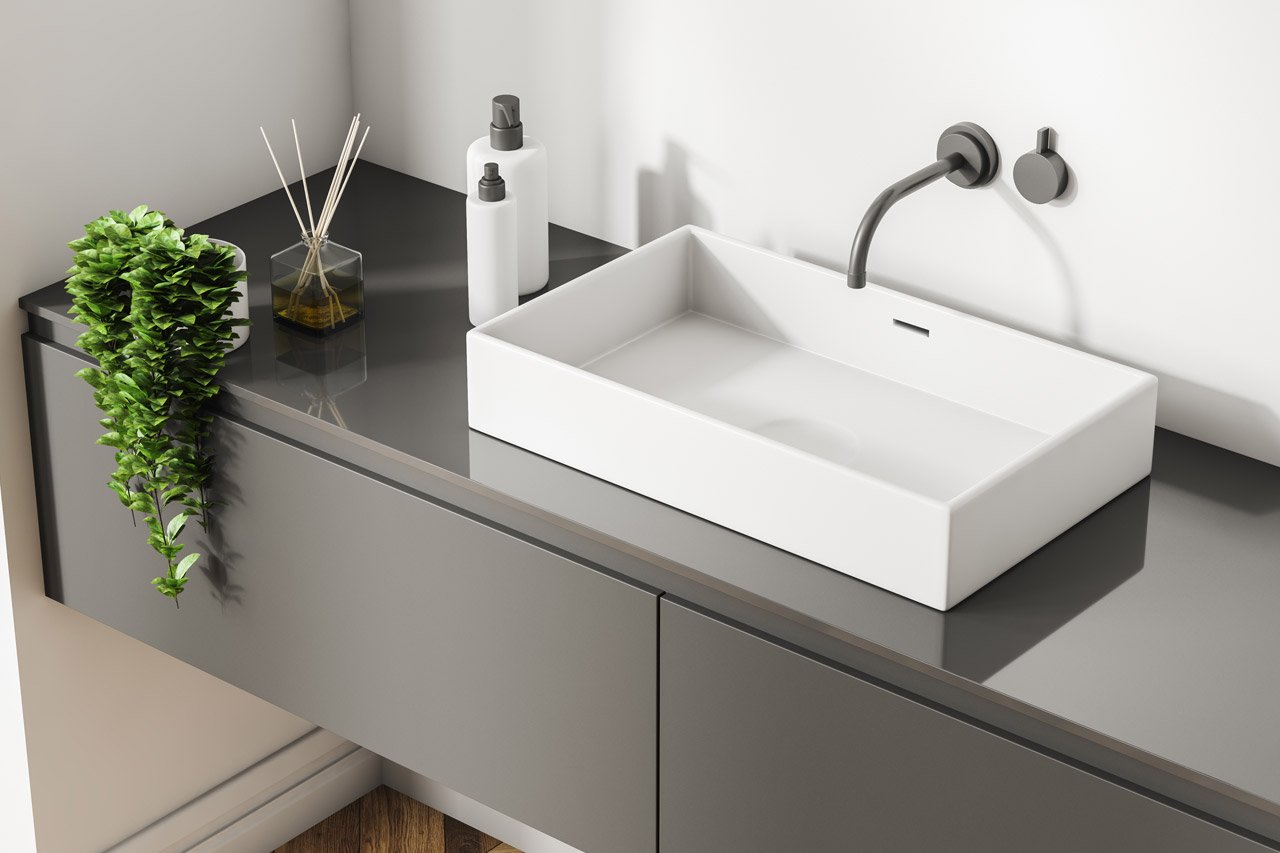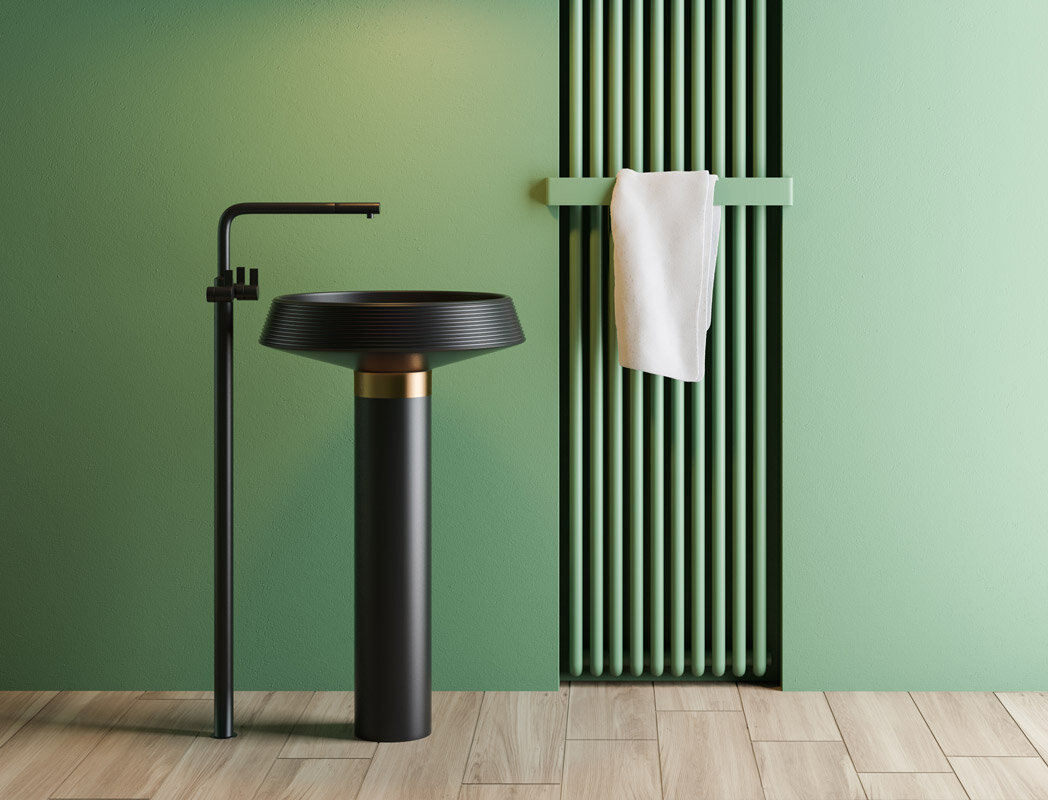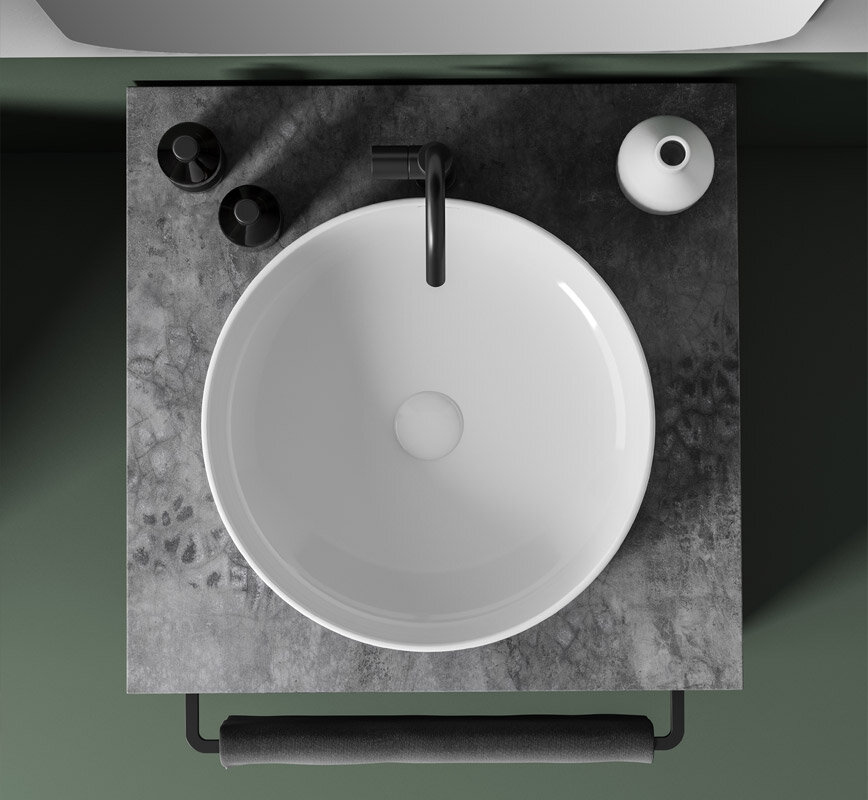How to choose washbasin and bathroom faucets - Our tips
31 August 2023

Types of washbasins and bathroom faucets
The basic criterion for dividing bathroom faucets is their installation. There are basin faucets that are wall-mounted, and those that are upright. The latter are divided into three types. These are basin faucets that can be floor-mounted, mounted on the sink rim and on the counter. Currently, the most popular are sink-mount faucets. At the same time, it’s a universal solution, which is the reason for its popularity. In terms of price, floor-mount faucets are the most expensive, but these only work for certain basins, so they can be seen far less often.
Like faucets, washbasins are also divided into several categories. Wall-hung basins are mounted in the wall or in a concealed frame. Then there are free-standing basins that have a pedestal and bowl. Undermount washbasins are mounted on the underside of the counter. If the basin slightly protrudes beyond the edge of the countertop, it’s a semi-recessed basin. In recessed models, on the other hand, its main part is under the counter, and above it is a ceramic rim. There are also basins that are placed on the counter and they are named countertop basins. When deciding on this option, it’s important to remember that the counter will be quite low. As we can see, the cross-section of options is quite wide, which washbasin will be the best? It depends on several factors.

How does the bathroom style affect the choice of basin and faucets?
One of the first factors taken into account when choosing a washbasin and faucets is the bathroom design style. Contemporary style requires different design patterns than loft or rustic arrangements. In each decor, there are certain guiding colors, materials that furnishings are usually made of. The design patterns are also different. In some cases, like the above-mentioned contemporary style, simplicity and minimalism are important, in other cases, as with retro style, refined forms are better. When planning a bathroom renovation, we need to make sure that all the elements are consistent in terms of style, and this also applies to the washbasin. For example, a matte washbasin, let’s say in black color, would be the ideal addition to the industrial decor, while for modern glam design it should be shiny. On the other hand, with Scandinavian bathrooms, it’s best to stick to traditional white ceramics.
Just as important is the choice of faucets - with glamorous interiors, they can be in gold, copper or black, while when looking for something that fits a contemporary interior, a chrome faucet will be a great option. Another question that needs to be answered is how to choose the tap for our basin.
High or low tap? How to choose a bathroom faucet
The washbasin and the faucet are always a set, they are inseparably related. This means that the answer to the question as to which faucet will work best for the basin depends on the type and size of the sink. What’s more, some of the commercially available basins have holes to mount a faucet, while others don’t.
It’s also important to maintain the proportions between the basin and the faucet. This is important for aesthetics and functionality. How to choose a faucet for the basin, considering the length of the spout? It’s recommended that there be at least a 15 cm space between the bottom of the basin and the spout. If the bathroom will have a large washbasin, it’s best to invest in a model with a longer spout and a high body. Similarly, with a small basin model, the spout should be shorter. Both the cambering and the length of the spout are important for convenience. A tap that is too long can make it difficult to put your hands under, while one that is too short can mean that water stream might not reach far enough. Besides, a wrong faucet selection doesn’t only translate into less comfort, but also into unnecessary splashing. A compromise that many investors opt for is a faucet where the stream comes out at an angle. And what kind of faucet for a small basin? The ideal model is one with a low spout that doesn’t take up too much space.
Based on what was said above, we can see that choosing a right set is not at all as simple as it seems. Therefore, the simplest solution is to opt for a faucet-sink set. Then it’s guaranteed that the dimensions and holes work well together. However, nothing stops us from selecting these elements separately. The cross-section of possibilities is broad, so we can be certain to find a faucet and basin that go well together. No matter if we are choosing a faucet for a countertop, undermount or free-standing basin, we need to keep in mind what was just mentioned. So what matters is the style, size and height of the bowl, as well as the size of the holes, if there are any. Since you already know how to choose the size of the faucet for the basin, we can move on to the next matter - the material that basins can be made of.

Washbasins - made of stone, ceramic, glass or plastic?
Washbasins are made of different materials. Depending on the design style, the colors used and the investor’s expectations, the ideal washbasin will be different. White ceramic is still the most common, but it’s not the only option. There are sinks made of other materials, like plastic, glass, wood and stone. What are the characteristics of the different types and which washbasin to choose?
Ceramic washbasins
Ceramic washbasins are versatile, work well in most bathrooms, and are available in many sizes and shapes. This is one of their greatest assets and reasons why they are so common. They are made from fire clay or fine stoneware. Such basins are characterized by high resistance to damage, scratches and temperature. They are also easy to clean and well-priced. Some models have a coating that prevents scale and dirt from settling. If you’re after something unique, you can buy a colored ceramic basin or one with painted patterns.
Plastic washbasins
Washbasins made of plastic can be an interesting option. They are scratch and crack resistant, easy to clean and lightweight. Like ceramic models, they aren’t very expensive and have a growing number of supporters. With too much pressure, they can deform, though.
Glass washbasins
In washbasins production, highly resistant tempered glass is used. Such basins look light and elegant. One of the qualities of glass is its plasticity during processing, so we can find washbasins in various, even non-standard shapes. What’s more, they come in many colors and patterns, can have bubbles, be frosted or stylized to look like metal. Quite cautious approach should be taken to clear sinks, as unsightly stains could form on them.
Stone washbasins
Stone washbasins are very durable and original. They are stable and scratch resistant, and using the appropriate cleaning products, cleaning them won’t be an issue. We have to accept, however, that soap and scale will settle, so systematic care is the key here. They are also heavy, which some people see as a disadvantage, as they need to have a reinforced base. Most often, stone basins are made of onyx, marble, granite or sandstone.
Wooden washbasins
Wood is not particularly associated with the bathroom. Most species have poor resistance to moisture, which is abundant in the bathroom. Exotic species - like iroko, teak and wenge - are a good choice since they don’t rot when exposed to moisture. They are warm to the touch, unique and, like all wooden elements, give the interior a pleasant atmosphere. When deciding on this option, be sure to get special cleaning and maintenance products as well.
Functionality vs. appearance - How to choose the perfect basin and faucet for the bathroom?
Creating a beautiful bathroom arrangement is quite a challenge. Especially when it comes to a place with limited space. There must always be room for a bathtub or a shower stall. It could be a simple corner enclosure, an extravagant walk-in screen, or a complete solution, such as a modular cabin, which SanSwiss offers in different sizes. A shower enclosure has to be complemented with a shower tray. For elegant options that don’t take up much space, it’s worth looking at ultra-slim shower trays. For greater convenience, various accessories and parts will be useful. Apart from a bathtub or shower unit, every bathroom has a toilet bowl, sometimes a bidet, plus a washbasin and faucets.
Based on what was said above, it’s much easier to find the answer to the question as to what washbasin to choose for the bathroom and how to select a faucet for our basin. We can also see that the wide cross-section of available models allows us to choose one that will match the overall design. Depending on whether we opt for something classic and subdued, or something expressive and original, the washbasin can be a distinctive color accent, or a discreet addition to the overall decor. Design is not everything, though, functionality also matters. The height of the tap, its length corresponding to the height and size of the basin are essential. To further increase convenience, and at the same time increase savings on water consumption, we can consider touchless faucets.